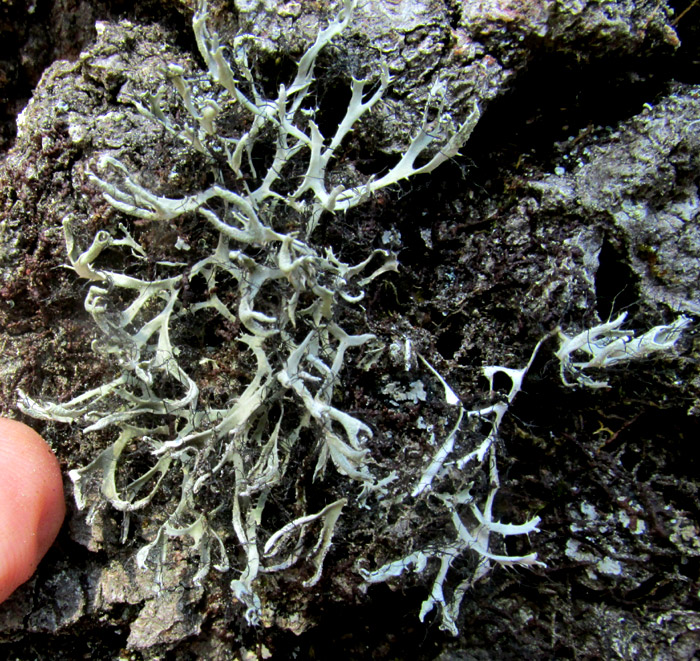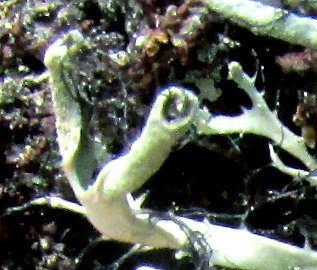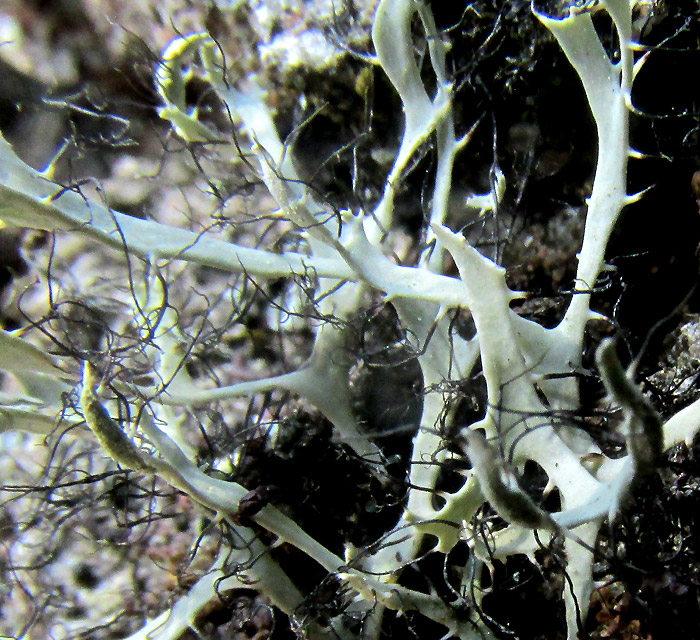Excerpts from Jim Conrad's
Naturalist Newsletter
Entry from field notes dated May 7, 2023, atop hill forested with pines and oaks about 1km east of Curva de la Doctorcilla, on unnamed road connecting Hwy120 and El Doctor; limestone bedrock; elevation ±2650m (8700 ft); Eastern Sierra Madre mountains of east-central Querétaro state, MÉXICO, (N20.88°, W99.62°)
HANGING FRINGED LICHEN ON DEAD PINE

Vast areas of oak-pine forest at the upper elevations of the Eastern Sierra Madres and other similar zones in Mexico have been attacked by pine beetles, killing untold numbers of trees. Here atop a forested hill nearly all the pines are dead or dying, opening up the understory to more light and wind.
Many kinds of lichen adorned all the trees' trunks and higher limbs. The above one, at shoulder level on a large trunk of a dying Pinus pseudostrobus, was attention getting despite its white, bushy growth form being so common, because up close tiny white, slender teeth arose along the thallus branches. The fingertip entering the picture assures us that the image isn't just black and white; also, it shows that the lichen tuft is fairly small relative to others, and that its thalli grow in a more diffuse manner than some similar species.

During lichen identification, it's always hoped that the unknown individual will bear distinctive spore-producing apothecia, which come in many species-specific variations. Our lichen bore no obvious apothecia, though, at the right, the round depression conceivably could be the beginnings of one, though maybe it's just a random permutation of folded thallus.

The above close-up shows this lichen's most distinctive morphological features. The short white "teeth" observed from farther away turn out to be just the bases of much longer, thinner, black, often branching "cilia." The cilia twists about entangling with other similar cilia, forming a kind of diffuse, black haziness. The cilia arises at thallus edges, not the open surfaces. Also worth noting is that the thalli themselves, instead of being round in cross-section, are flattish or sometimes triangular in cross-section, and the thalli's widths vary markedly.
My amateur's knowledge didn't help me guess the genus or even family of this lichen, nor did the usual identification keys help. The only option was to look for matching pictures on the Internet, searching on such keywords as "lichen black cilia." After much staring at bushy, white lichens, matching images turned up labeled as ANAPTYCHIA CRINALIS, sometimes called Hanging Fringe Lichens.
The trouble with that name is that it's predominantly a Eurasian species, and in North America mainly is documented sporadically from the Arctic south into the northern US, but with one in mountainous southern Arizona.
Finally I noticed that even though LichenPortal.Org's current occurrences map for Anaptychia crinalis indicates no occurrences in Mexico, in its word description of the species' distribution it adds at the end, in parentheses, "(incl Mexico)." Possibly this was added recently after a new find, and the map hasn't been updated yet. No indication is given where in Mexico it's been observed, and currently no Internet search on the keywords "Anaptychia crinalis Mexico" returns a reference to such a find. Also, the Arizona collection was in the Chiricahua Mountains not far from the Mexican border, at an elevation nearly as high as here.
In the northern US state of Wisconsin, the species is described as inhabiting forest edges, especially in calcium-rich areas. Our open forest with its dead and dying pines lets in light and air like a forest edge, and our limestone rock certainly is calcium rich.
Hanging Fringed Lichens seem to like it cool to very cold, and maybe that explains the gauzy network of intermeshed black cilia arising from the thalli's margins. The blackness might gather heat and transfer it into the thalli. But that's just speculation, until someone studies the matter.
On Web pages and in many lists, often a general confusion is observed regarding a complex of three closely related and very similar species, one of which is our Anaptychia crinalis. The other two species are Anaptychia ciliaris and Anaptychia setifera. In Theodore L. Esslinger's 2007 study entitled "A Synopsis of the North American Species of Anaptychia (Physciaceae)," it's emphasized that the only species of the complex known to exist in North America as of the publication date was ours, Anaptychia crinalis. That insight figures into my identification, because on the Web and in publications, numerous lists and identified images report all three species in North America. It's assumed that in North America we just have Anaptychia crinalis
Still, this ID is not at all solid. For one thing, when a single species occurs in the Arctic tundra, as well as arid south-Arizona mountains, and apparently here, one can't be surprised if eventually one or more "cryptospecies" are involved -- cryptospecies being those looking like one another, but which are reproductively isolated from one another. I regard our determination of Anaptychia crinalis as a place-holder name, waiting for a specialist to come along someday to clarify things.
Whatever the case, the beetle-killed pines dropping their needles and opening up the understory to light and coolish breezes here at an elevation of ±2650m on this limestone mountain, seem to have created an acceptable environment for our Hanging Fringed Lichen. Somehow a spore from far away made it to here, maybe hitching a ride beneath feathers of a neotropical migrant warbler who'd nested in the far north, and overwintered here, or was just passing through during migration. It'd be fun to know the story behind this little lichen's surprising presence here.